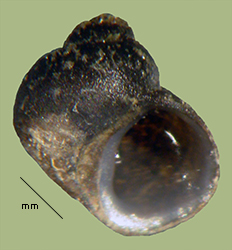> Habitat & Distribution
Somatogyrus integra populations are widespread in western Pennsylvania, especially in the Allegheny River, but spotty elsewhere in the main Ohio and its richer tributaries the Licking, the Salt, and the Wabash. The snail is typically found in rocky riffles with good flow, a habitat that has become rather rare in the modern era. Thomas Say (1829) observed, "this is a very common little shell, abounding more in many situations than any other species, particularly in the vicinity of the Falls of the Ohio," but very little malacofauna of any sort inhabits the Ohio River around Louisville today. FWGNA incidence rank I-4.
> Ecology & Life History
Hydrobioid populations seem to be rather nonspecific grazers of small particles (Dillon 2000: 94-97). They are typically dioecious, the males being characterized by a penis that arises from the neck. Eggs are generally laid singly, attached in a spare capsule to a solid substrate. We are unaware of any good study on any aspect the biology of Somatogyrus.
> Taxonomy & Systematics
Somatogyrus may be confused with several other taxa of plainly-shelled hydrobioids inhabiting drainages of The Ohio. In contrast to Amnicola and Lyogyrus (of the Amnicolidae) and to Cincinnatia (of the Hydrobiidae ss), penial morphology in the family Lithoglyphidae (to which Somatogyrus belongs) is simple and unlobed, with just the single duct. Birgella and Somatogyrus are difficult to distinguish on the basis of penial morphology, but adults of the former are twice as large as the latter. Burch (1989) divided Somatogyrus into two subgenera (Walkerilla and Somatogyrus ss) but later opinions suggest little basis for the distinction (Thompson 1984).
The Latin integra means complete or whole or perfect. Thus it is more than a bit ironic that Say described two freshwater gastropods with that distinctive specific nomen, Paludina integra (Say 1821) and Melania integra (Say 1829), and that Paludina integra became widely associated with two very different snails, one subsequently assigned to the genus Campeloma, and the other to the genus Cincinnatia. Hershler & Thompson (1996) resolved the Paludina integra confusion in favor of Cincinnatia. Meanwhile the Say nomen Melania integra receded into obscurity.
Say's brief (1829) description of Melania integra specified a subglobose shell "nearly one-fifth of an inch," which would seem to rule out a pleurocerid, inhabiting "the Ohio and many of its tributaries." On that basis Baker (1928) suggested that Melania integra might best be reassigned to the genus Somatogyrus.
One might hope that the small, plain, rather featureless shell and gentalia mounted by North American populations of Somatogyrus might protect the group from the multiplication of synonyms that has cursed so many of our other freshwater gastropod groups. But no. The Somatogyrus populations widely scattered about Ohio drainages today have been described at least twice subsequent to 1829, as depressus (Tryon 1862) and trothis (Doherty 1878). Walker described S. pennsylvanicus from just east of the continental divide in 1904, and Pilsbry & Baker added S. tryoni from just north up the Mississippi basin in 1927.
Regarding the former, typical shells borne by S. pennsylvanicus populations do indeed seem a bit lighter and more inflated than is characteristic of S. integra. Regarding the latter, we have no personal observations. Pilsbry & Baker stated that the shells of their S. tryoni are characterized by a longer spire and more rounded whorls than is typical for S. integra. The biological significance of any of these distinctions remains an open question.
> Maps and Supplementary Resources
> Essays
- The 1904 description of Somatogyrus pennsylvanicus was touched upon in my 9Nov12 essay reviewing the life and work of Bryant Walker, "Bryant Walker's Sense of Fairness."
- Earlier versions of this website, online until August of 2016, adopted the large, broadly-inclusive concept of the Hydrobiidae (sl) following Kabat & Hershler (1993). More recently the FWGNA project has shifted to the Wilke et al. (2013) classification system, distinguishing a much smaller Hydrobiidae (ss) and elevating many hydrobioid taxa previously ranked as subfamilies to the full family level. For more details, see The Classification of the Hydrobioids.
> References
Baker, F. C. (1928) The
Fresh Water Mollusca of Wisconsin. Wisc. Geol. Nat. Hist.
Survey Bulletin 70, pp 1 - 507.
Burch, J. B. (1989) North American Freshwater
Snails. Malacological Publications, Hamburg, Michigan.
365 pp.
Dillon,
R.T., Jr. (2000) The Ecology of Freshwater Molluscs.
Cambridge University Press, Cambridge, United Kingdom. 509 pp.
Evans, R. and S. Ray
(2010) Distribution
and environmental influences of freshwater gastropods from lotic
systems and springs in Pennsylvania, USA, with conservation
recommendations. Amer. Malac. Bull. 28: 135 - 150.
Hershler,
R. & F.G. Thompson (1996) Redescription
of Paludina
integra Say,
1821, type species of genus Cincinnatia (Gastropoda:
Hydrobiidae). J. Moll. Stud. 62: 33 - 55.
Kabat, A.R., and R.
Hershler (1993)
The prosobranch snail family Hydrobiidae (Gastropoda: Rissooidea):
review of classification and supraspecific taxa. Smithsonian
Contributions to Zoology 547:1-94.
Pilsbry, H. A. and F. C.
Baker (1927) Description of a news species of Somatogyrus from
Wisconsin. Nautilus 41: 24 - 27.
Say, T. (1821) Descriptions
of univalve shells of the United States. J. Acad. Nat. Sci.
Phila. 2(1): 149 - 179.
Say, T. (1829) Descriptions of some new
terrestrial and fluviatile shells of North America. New
Haromy Disseminator of Useful Knowledge.
Thompson, F. (1984)
North American freshwater snail genera of the hydrobiid subfamily
Lithoglyphinae. Malacologia 25: 109-141.
Walker, B.
(1904) New species of Somatogyrus.
Nautilus 17: 133-142.
Wilke T., Haase M., Hershler R.,
Liu H-P., Misof
B., Ponder W. (2013)
Pushing short DNA
fragments to the limit: Phylogenetic relationships of “hydrobioid”
gastropods
(Caenogastropoda: Rissooidea). Molecular
Phylogenetics and Evolution 66: 715 – 736.








